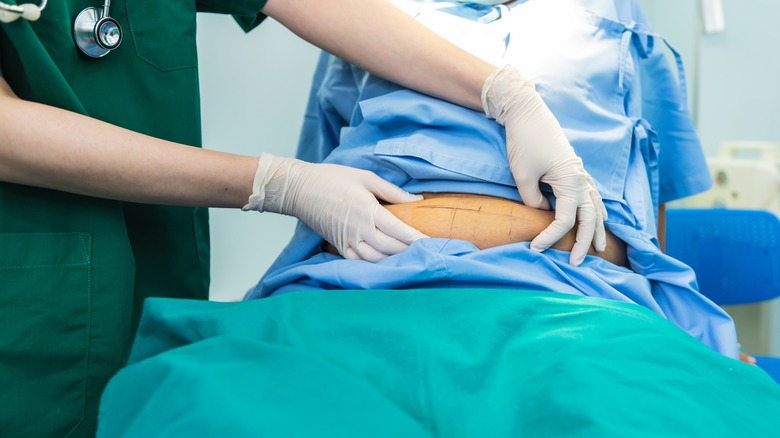What Is An Apron Belly And What Can You Do To Reduce It?
An apron belly, also known as a panniculus or a hanging belly, is a condition where excess fat and skin accumulate around the abdomen, causing it to sag and hang down, says Medical News Today. This condition can result in a protruding appearance of the abdomen, which can be uncomfortable and even embarrassing for some people.
Several factors can contribute to the development of an apron belly. Firstly, being overweight or obese is one of the most common causes. Excess body weight can cause fat to accumulate in the abdomen. However, if you've recently lost significant weight, excess skin can also hang around the abdomen and may cause an apron belly if it doesn't return to its original size. This can also happen due to pregnancy — after childbirth, the excess skin that stretched to accommodate the growing fetus may appear as a pannus belly.
Gender is another contributing factor to belly fat accumulation, per a Panniculectomy. Men and women tend to store fat differently, and this can affect the appearance of belly fat. Generally speaking, men tend to accumulate more belly fat than women, especially as they age.
The size of an apron belly can vary from person to person. In some cases, an apron belly may be small and only mildly noticeable and will sit at the pubic area, while in other cases, it can be large and hang down several inches or even reach the thighs or knees, says Healthline.
What can you do to reduce an apron belly?
Reducing an apron belly can be challenging, but it is possible. For mild cases, healthy lifestyle changes through diet and exercise may help reduce apron belly, and also improve overall health (per Medical News Today).
The best way to reduce an apron belly is by losing overall body fat — so when it comes to exercise, while it may be tempting to try to spot target the abdomen with exercises like crunches, a better approach is a full-body workout regime. The Centers for Disease Control and Prevention (CDC) generally recommends engaging in 30 minutes of moderate-intensity workouts 5 days a week or 150 minutes a week. Cardiovascular exercises such as brisk walking can help burn calories and reduce overall body fat, says Medical News Today. The CDC also advises adults to engage in strength training exercises two days a week. Building muscle can help increase your metabolic resting rate and reduce body fat, explains Healthline. Try incorporating strength training exercises like squats, push-ups, and bench presses.
Diet is perhaps the more important part of the picture — as Medical News Today notes, weight loss is generally not propelled by exercise alone. A healthy diet rich in fruits, vegetables, whole grains, and lean proteins is usually recommended. Good hydration is also essential. Drinking plenty of water can help you feel full and reduce your calorie intake. It can also help flush toxins from your body and reduce bloating (via Medical News Today).
Other treatment options for apron belly
Laser liposuction and CoolSculpting procedures are non-invasive treatments that can be used to target and reduce fat in the abdominal area. These treatments are popular because they are generally considered safe, have minimal side effects, require minimal recovery time, and can be performed on an outpatient basis, says Healthline.
Surgery to remove the pannus, also known as a panniculectomy, may be an option for cases where weight loss and exercise do not improve the condition. Surgery is typically performed as a tummy tuck or abdominoplasty, according to Medical News Today. This is a major surgery that involves a longer recovery time, but it can provide dramatic results. During the procedure, the surgeon will remove excess skin and fat from the abdomen and tighten the abdominal muscles.
The surgery is performed under general anesthesia and may take several hours to complete. The surgeon will make an incision across the lower abdomen and remove the excess skin and fat. The surgeon will then drain excess fat and fluids with drainage tubes inserted inside the abdomen, and muscles will also be tightened to improve the contour of the abdomen. Finally, your surgeon may advise you to wear compression garments until the fluids are drained and the healing process is complete.
It's important to note that each treatment option has its own risks and benefits, and it's essential to consult with your doctor to determine the best course of action for your situation.


